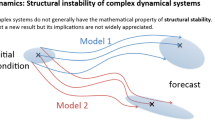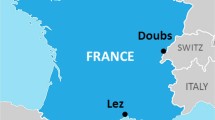Abstract
We present a polynomial chaos-based framework to quantify the uncertainties in predicting hurricane-induced storm surges. Perturbation strategies are proposed to characterize poorly known time-dependent input parameters, such as tropical cyclone track and wind as well as space-dependent bottom stresses, using a handful of stochastic variables. The input uncertainties are then propagated through an ensemble calculation and a model surrogate is constructed to represent the changes in model output caused by changes in the model input. The statistical analysis is then performed using the model surrogate once its reliability has been established. The procedure is illustrated by simulating the flooding caused by Hurricane Gustav 2008 using the ADvanced CIRCulation model. The hurricane’s track and intensity are perturbed along with the bottom friction coefficients. A sensitivity analysis suggests that the track of the tropical cyclone is the dominant contributor to the peak water level forecast, while uncertainties in wind speed and in the bottom friction coefficient show minor contributions. Exceedance probability maps with different levels are also estimated to identify the most vulnerable areas.
Similar content being viewed by others
References
Berg, E.V.D., Friedlander, M.P.: SPGL1: a solver for large-scale sparse reconstruction. [Available online at http://www.cs.ubc.ca/labs/scl/spgl1] (2007)
Berg, E.V.D., Friedlander, M.P.: Probing the Pareto frontier for basis pursuit solutions. SIAM J. Sci. Comp. 31(2), 890–912 (2008). https://doi.org/10.1137/080714488. http://link.aip.org/link/?SCE/31/890
Beven, J.L. II, Kimberlain, T.B.: Tropical cyclone report - hurricane Gustav. Tech. rep., National Oceanic and Atmospheric Administration/NHC. [Available online at http://www.nhc.noaa.gov/data/tcr/AL072008_Gustav.pdf] (2009)
Brown, J.D., Spencer, T., Moeller, I.: Modeling storm surge flooding of an urban area with particular reference to modeling uncertainties: a case study of Canvey Island, United Kingdom. Water Resour. Res. 43(6). https://doi.org/10.1029/2005WR004597. https://agupubs.onlinelibrary.wiley.com/doi/abs/10.1029/2005WR004597 (2007)
Chen, S.S., Donoho, D.L., Saunders, M.A.: Atomic decomposition by basis pursuit. SIAM J. Sci. Comp. 20, 33–61 (1998)
Crestaux, T., Le Maître, O., Martinez, J.M.: Polynomial chaos expansion for sensitivity analysis. Reliab. Eng. and Syst. Saf. 94(7), 1161–1172 (2009)
Cruz-Jiménez, H., Li, G., Mai, P., Hoteit, I., Knio, O.: Bayesian inference of earthquake rupture models using polynomial chaos expansion. Geosci. Model Dev. 11(7), 3071–3088 (2018). https://doi.org/10.5194/gmd-11-3071-2018. https://www.geosci-model-dev.net/11/3071/2018/
Dietrich, J.C.: Coauthors: a high-resolution coupled riverine flow, tide, wind, wind wave, and storm surge model for Southern Louisiana and Mississippi. Part II: synoptic description and analysis of hurricanes Katrina and Rita. Mon. Weather Rev. 138(2), 378–404 (2010). https://doi.org/10.1175/2009MWR2907.1
Dietrich, J.C.: Coauthors: hurricane Gustav (2008) waves and storm surge: hindcast, synoptic analysis, and validation in Southern Louisiana. Mon. Weather Rev. 139(8), 2488–2522 (2011). https://doi.org/10.1175/2011MWR3611.1
Elsheikh, A.H., Hoteit, I., Wheeler, M.F.: Efficient Bayesian inference of subsurface flow models using nested sampling and sparse polynomial chaos surrogates. Comput. Methods Appl. Mech. Engrg. 269, 515–537 (2014). https://doi.org/10.1016/j.cma.2013.11.001. http://www.sciencedirect.com/science/article/pii/S004578251300296X
Finocchio, P.M., Majumdar, S.J., Nolan, D.S., Iskandarani, M.: Idealized tropical cyclone responses to the height and depth of environmental vertical wind shear. Mon. Weather Rev. 144(6), 2155–2175 (2016). https://doi.org/10.1175/MWR-D-15-0320.1
Flowerdew, J., Horsburgh, K., Wilson, C., Mylne, K.: Development and evaluation of an ensemble forecasting system for coastal storm surges. Quart. J. Roy. Meteor. Soc. 136(651), 1444–1456 (2010). https://doi.org/10.1002/qj.648. https://rmets.onlinelibrary.wiley.com/doi/abs/10.1002/qj.648
Forbes, C., Luettich, R.A. JR, Mattocks, C.A., Westerink, J.J.: A retrospective evaluation of the storm surge produced by hurricane Gustav. Forecast and Hindcast Results. Weather Forecast. 25(6), 1577–1602 (2010). https://doi.org/10.1175/2010WAF2222416.1 (2008)
Formaggia, L., Guadagnini, A., Imperiali, I., Lever, V., Porta, G., Riva, M., Scotti, A., Tamellini, L.: Global sensitivity analysis through polynomial chaos expansion of a basin-scale geochemical compaction model. Comput. Geosci. 17(1), 25–42 (2013). https://doi.org/10.1007/s10596-012-9311-5
Ghanem, R.G., Spanos, S.D.: Stochastic Finite Elements: a Spectral Approach. Springer, Berlin (1991)
Giraldi, L., Le Maître, O., Mandli, K., Dawson, C., Hoteit, I., Knio, O.: Bayesian inference of earthquake parameters from buoy data using a polynomial chaos-based surrogate. Comput. Geosci. 21(4), 683–699 (2017). https://doi.org/10.1007/s10596-017-9646-z
Graham, L., Butler, T., Walsh, S., Dawson, C., Westerink, J.J.: A measure-theoretic algorithm for estimating bottom friction in a coastal inlet: case study of bay St. Louis during hurricane Gustav. Mon. Weather Rev. 145(3), 929–954 (2017). https://doi.org/10.1175/MWR-D-16-0149.1
Heaps, N.S.: Storm surges, 1967–1982. Geophys. J. Roy. Astro. Soc. 74(1), 331–376 (1983). https://doi.org/10.1111/j.1365-246X.1983.tb01883.x. https://onlinelibrary.wiley.com/doi/abs/10.1111/j.1365-246X.1983.tb01883.x
Holland, G.J.: An analytic model of the wind and pressure profiles in hurricanes. Mon. Weather Rev. 108(8), 1212–1218 (1980). https://doi.org/10.1175/1520-0493(1980)108<1212:AAMOTW>2.0.CO;2
Homma, T., Saltelli, A.: Importance measures in global sensitivity analysis of nonlinear models. Reliab. Eng. and Syst. Saf. 52(1), 1–17 (1996). https://doi.org/10.1016/0951-8320(96)00002-6. http://www.sciencedirect.com/science/article/pii/0951832096000026
Houze, R.A.: Cloud Dynamics. International Geophysics. Elsevier Science. https://books.google.fr/books?id=5DKWGZwBBEYC (1994)
Irish, J.L., Resio, D.T., Cialone, M.A.: A surge response function approach to coastal hazard assessment. Part 2: quantification of spatial attributes of response functions. Nat. Hazards 51(1), 183–205 (2009). https://doi.org/10.1007/s11069-009-9381-4
Iskandarani, M., Wang, S., Srinivasan, A., Thacker., W.C., Winokur, J., Knio, O.: An overview of uncertainty quantification techniques with application to oceanic and oil-spill simulations. J. Geophys. Res.: Oceans 121(4), 2789–2808 (2016). https://doi.org/10.1002/2015JC011366
Jia, G., Taflanidis, A.A., Nadal-Caraballo, N.C., Melby, J.A., Kennedy, A.B., Smith, J.M.: Surrogate modeling for peak or time-dependent storm surge prediction over an extended coastal region using an existing database of synthetic storms. Nat. Hazards 81(2), 909–938 (2016). https://doi.org/10.1007/s11069-015-2111-1
Kennedy, A.B.: Coauthors: origin of the hurricane Ike forerunner surge. Geophys. Res. Lett. 38(L08608). https://doi.org/10.1029/2011GL047090. https://agupubs.onlinelibrary.wiley.com/doi/abs/10.1029/2011GL047090 (2011)
Köppel, M., Franzelin, F., Kröker, I., Oladyshkin, S., Santin, G., Wittwar, D., Barth, A., Haasdonk, B., Nowak, W., Pflüger, D., Rohde, C.: Comparison of data-driven uncertainty quantification methods for a carbon dioxide storage benchmark scenario. Comput. Geosci. 23(2), 339–354 (2019). https://doi.org/10.1007/s10596-018-9785-x
Le Maître, O.P., Knio, O.M.: Spectral Methods for Uncertainty Quantification. Scientific Computation, Springer (2010)
Li, G., Curcic, M., Iskandarani, M., Chen, S.S., Knio, O.M.: Uncertainty propagation in coupled Atmosphere–Wave–Ocean prediction system: a study of hurricane Earl. Mon. Weather Rev. 147(1), 221–245 (2019). https://doi.org/10.1175/MWR-D-17-0371.1
Li, G., Iskandarani, M., Le Hénaff, M., Winokur, J., Le Maître, O.P., Knio, O.M.: Quantifying initial and wind forcing uncertainties in the Gulf of Mexico. Comput. Geosci. 20(5), 1133–1153 (2016). https://doi.org/10.1007/s10596-016-9581-4
Lin, N., Chavas, D.: On hurricane parametric wind and applications in storm surge modeling. J. Geophys. Res.: Atmospheres 117(D9), n/a–n/a (2012). https://doi.org/10.1029/2011JD017126. D09120
Lorenz, E.N.: Empirical orthogonal functions and statistical weather prediction. Scientific report / MIT. Statistical Forecasting Project. Massachusetts Institute of Technology, Department of Meteorology. https://books.google.com/books?id=2cQIogEACAAJ (1956)
Luettich, R.A., Westerink J.J.: Formulation and numerical implementation of the 2D/3D ADCIRC finite element model version 44.XX (2004)
Mayo, T., Butler, T., Dawson, C., Hoteit, I.: Data assimilation within the advanced circulation (ADCIRC) modeling framework for the estimation of Manning’s friction coefficient. Ocean Model. 76, 43–58 (2014). https://doi.org/10.1016/j.ocemod.2014.01.001. http://www.sciencedirect.com/science/article/pii/S146350031400002X
Mel, R., Viero, D.P., Carniello, L., Defina, A., D’Alpaos, L.: Simplified methods for real-time prediction of storm surge uncertainty: The city of Venice case study. Adv. Water. Resour. 71, 177–185 (2014). https://doi.org/10.1016/j.advwatres.2014.06.014. http://www.sciencedirect.com/science/article/pii/S0309170814001316
Molteni, F., Buizza, R., Palmer, T.N., Petroliagis, T.: The ECMWF ensemble prediction system: methodology and validation. Quart. J. Roy. Meteor. Soc. 122(529), 73–119 (1996). https://doi.org/10.1002/qj.49712252905. https://rmets.onlinelibrary.wiley.com/doi/abs/10.1002/qj.49712252905
Morokoff, W.J., Caflisch, R.E.: Quasi-Monte Carlo integration. J. Comput. Phys. 122(2), 218–230 (1995). https://doi.org/10.1006/jcph.1995.1209. http://www.sciencedirect.com/science/article/pii/S0021999185712090
Myers, V.A.: Storm tide frequencies on the South Carolina Coast. Tech. Rep. NWS. 16 NOAA (1975)
Navarro, M., Le Maître, O., Hoteit, I., George, D., Mandli, K., Knio, O.: Surrogate-based parameter inference in debris flow model. Comput. Geosci. 22(6), 1447–1463 (2018). https://doi.org/10.1007/s10596-018-9765-1
NOAA/NHC: Tropical cyclone report, hurricane Gustav (AL072008). [Available online at http://ftp.nhc.noaa.gov/atcf/archive/2008/bal072008.dat.gz] (2008)
Powell, M.D.: Drag coefficient distribution and wind speed dependence in tropical cyclones. Final report to the NOAA joint hurricane testbed (JHT) program, 26p NOAA/atlantic oceanographic and meteorological laboratory (2006)
Resio, D.T., Powell, N.J., Cialone, M.A., Das, H.S., Westerink, J.J.: Quantifying impacts of forecast uncertainties on predicted storm surges. Nat. Hazards 88(3), 1423–1449 (2017).
Rohmer, J., Lecacheux, S., Pedreros, R., Quetelard, H., Bonnardot, F., Idier, D.: Dynamic parameter sensitivity in numerical modelling of cyclone-induced waves: a multi-look approach using advanced meta-modelling techniques. Nat. Hazards 84(3), 1765–1792 (2016). https://doi.org/10.1007/s11069-016-2513-8
Sobol, I.M.: Sensitivity estimates for nonlinear mathematical models. Math. Model. Comput. Exp. 1, 407–414 (1993)
Sochala, P., De Martin, F.: Surrogate combining harmonic decomposition and polynomial chaos for seismic shear waves in uncertain media. Comput. Geosci. https://doi.org/10.1007/s10596-017-9677-5 (2017)
Sochala, P., Le Maître, O.: Polynomial Chaos expansion for subsurface flows with uncertain soil parameters. Adv. Water. Resour. 62, 139–154 (2013). https://doi.org/10.1016/j.advwatres.2013.10.003. https://hal.archives-ouvertes.fr/hal-00931639
Song, Y.K., Irish, J.L., Udoh, I.E.: Regional attributes of hurricane surge response functions for hazard assessment. Nat. Hazards 64(2), 1475–1490 (2012). https://doi.org/10.1007/s11069-012-0309-z
Taylor, G.I.: Skin friction of the wind on the earth’s surface. Proc. Roy. Soc. London A92(637), 196–199 (1916). https://doi.org/10.1098/rspa.1916.0005. http://rspa.royalsocietypublishing.org/content/92/637/196
Taylor, N.R., Irish, J.L., Udoh, I.E., Bilskie, M.V., Hagen, S.C.: Development and uncertainty quantification of hurricane surge response functions for hazard assessment in coastal bays. Nat. Hazards 77(2), 1103–1123 (2015). https://doi.org/10.1007/s11069-015-1646-5
Thompson, E.F., Cardone, V.J.: Practical modeling of hurricane surface wind fields. J. Waterw. Port. Coast. 122(4), 195–205 (1996). https://doi.org/10.1061/(ASCE)0733-950X(1996)122:4(195). http://ascelibrary.org/doi/abs/10.1061/1996
Toro, G.R., Resio, D.T., Divoky, D., Niedoroda, A.W., Reed, C.: Efficient joint-probability methods for hurricane surge frequency analysis. Ocean Eng. 37(1), 125–134 (2010). https://doi.org/10.1016/j.oceaneng.2009.09.004. http://www.sciencedirect.com/science/article/pii/S0029801809002236
Zheng, F., Westra, S., Leonard, M., Sisson, S.A.: Modeling dependence between extreme rainfall and storm surge to estimate coastal flooding risk. Water Resour. Res. 50(3), 2050–2071 (2014). https://doi.org/10.1002/2013WR014616. https://agupubs.onlinelibrary.wiley.com/doi/abs/10.1002/2013WR014616
Funding
The work of P. Sochala is supported by a funding of BRGM (French Geological Survey) through its Institut Carnot sponsored by the ANR (French National Research Agency). This research was made possible in part by a grant from The Gulf of Mexico Research Initiative to the Consortium for Advanced Research on Transport of Hydrocarbon in the Environment (CARTHE) and by NSF 1639722 and NSF 1818847.
Author information
Authors and Affiliations
Corresponding author
Additional information
Data availability
Data are publicly available through the Gulf of Mexico Research Initiative Information & Data Cooperative (GRIIDC) at https://doi.org/https://data.gulfresearchinitiative.org (https://doi.org/10.7266/N73777BS).
Publisher’s note
Springer Nature remains neutral with regard to jurisdictional claims in published maps and institutional affiliations.
Appendix: Holland model
Appendix: Holland model
This parametric model [19] describes a symmetrical vortex and is derived by starting with an empirical analytical pressure field and by using the gradient wind equation to get the wind speed profile. The pressure field p is assumed to have an exponential profile,
where r is the radial distance from the eye, t the time variable, pc(t) the central pressure, pa(t) the ambient pressure (at infinite radius), Rmw(t) the maximum wind radius (RMW), and B the Holland parameter. Plugging the pressure profile (28) into the gradient wind equation [21] and neglecting the Coriolis force (assumed to be small in the region of maximum winds) leads to the following tangential wind speed profile,
where the maximum wind speed \(v_{\max \limits }(t)\) has been introduced. This latter quantity is defined as v(r = Rmw,t) = (B(pa(t) − pc(t))/(ρae))1/2 with \(\rho _{\mathrm {a}}=1.18\text {kg/m}^{3}\) the air density, and e = 2.72 the Euler’s number. Assuming that the central pressure and the maximum wind speed are known, the ambient pressure in Eq. 28 is then computed with \(p_{\mathrm {a}}(t)=p_{\mathrm {c}}(t)+\rho _{\mathrm {a}} e v_{\max \limits }^{2}(t)/B\). The shape parameter B of the model determines the steepness of the eyewall and the strength of the winds far from the center. Its value ranges over the interval [0.5, 2.5] as mentioned in [49] and we set B = 1.
Rights and permissions
About this article
Cite this article
Sochala, P., Chen, C., Dawson, C. et al. A polynomial chaos framework for probabilistic predictions of storm surge events. Comput Geosci 24, 109–128 (2020). https://doi.org/10.1007/s10596-019-09898-5
Received:
Accepted:
Published:
Issue Date:
DOI: https://doi.org/10.1007/s10596-019-09898-5




